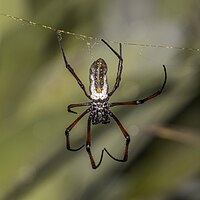
Photo from wikipedia
Abstract In light of the ongoing global biodiversity crisis, the urge to monitor and map terrestrial plant biodiversity at large spatial extents has spurred research on adequate quantitative methods. The… Click to show full abstract
Abstract In light of the ongoing global biodiversity crisis, the urge to monitor and map terrestrial plant biodiversity at large spatial extents has spurred research on adequate quantitative methods. The use of spectral diversity metrics from different remote sensing platforms has emerged as a promising tool for such biodiversity assessments. Satellite remote sensing presents the next frontier for implementation of these methods to assess plant diversity with spatial and temporal continuity at truly regional or global scales. However, the question of what exactly is monitored by spectral diversity metrics from relatively coarse multi-spectral satellite observations has remained largely unanswered. In this research, we examined which components contribute to satellite remotely sensed spectral diversity. We assessed the relationships between spectral diversity and in-situ taxonomic and trait diversity, and evaluated the role of confounding factors, vegetation cover, and landscape morphology (slope and elevation), in shaping these relationships. Hereto, we used Sentinel-2 imagery and in-situ field trait and species count data collected in the Montesinho-Nogueira Natura 2000 site (Portugal) together with radiative transfer models to quantify the theoretical link between in-situ trait diversity and simulated spectral diversity. Through the use of linear mixed-effect models, our results highlight that variation in vegetation cover dominates the Sentinel-2's spectral diversity signal (contributing 53–84% of the R2marginal). The vegetation cover component encompasses spatial variability in canopy architecture traits as well as the fraction of bare soil and plant litter spectra. These elements together strongly impact the overall spectral diversity signal, as shown both in our radiative transfer simulations and empirical comparisons. Next to vegetation cover, we found that taxonomic diversity is a significant predictor and covariate of spectral diversity, while the role of leaf trait diversity appeared insignificant in our multispectral dataset. Variation in vegetation cover dominated the spectral diversity signal in our study while it is not necessarily correlated with plant diversity. We, therefore, recommend that future applications of multi-spectral diversity metrics consider the impact of vegetation cover, including soil variability and the role of morphological traits, in shaping leaf trait - canopy reflectance relationships to better understand the ambiguous performance of spectral diversity as a proxy of plant diversity. This will result in higher robustness, consistency, and scalability of spectral diversity metrics for predicting in-situ plant diversity across scales, sensors, and ecosystems in regional biodiversity assessments.
Journal Title: Remote Sensing of Environment
Year Published: 2021
Link to full text (if available)
Share on Social Media: Sign Up to like & get
recommendations!